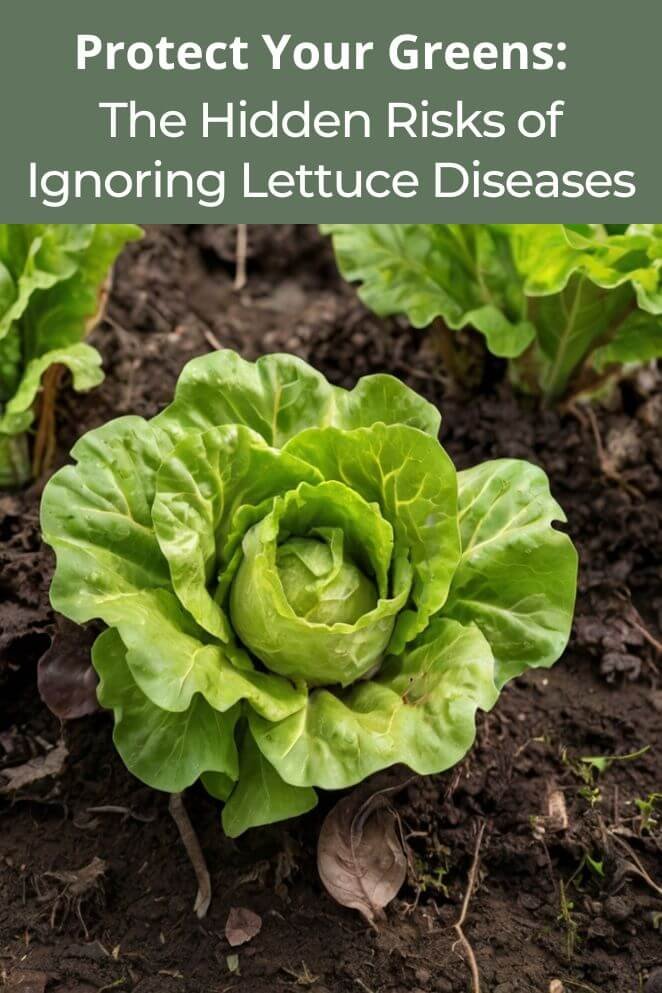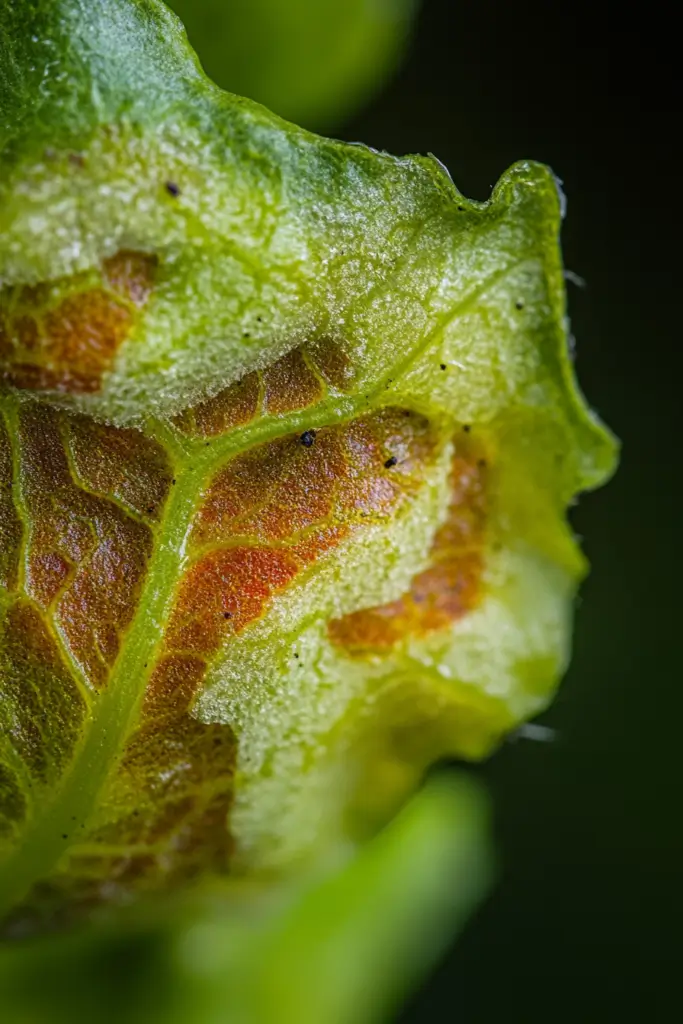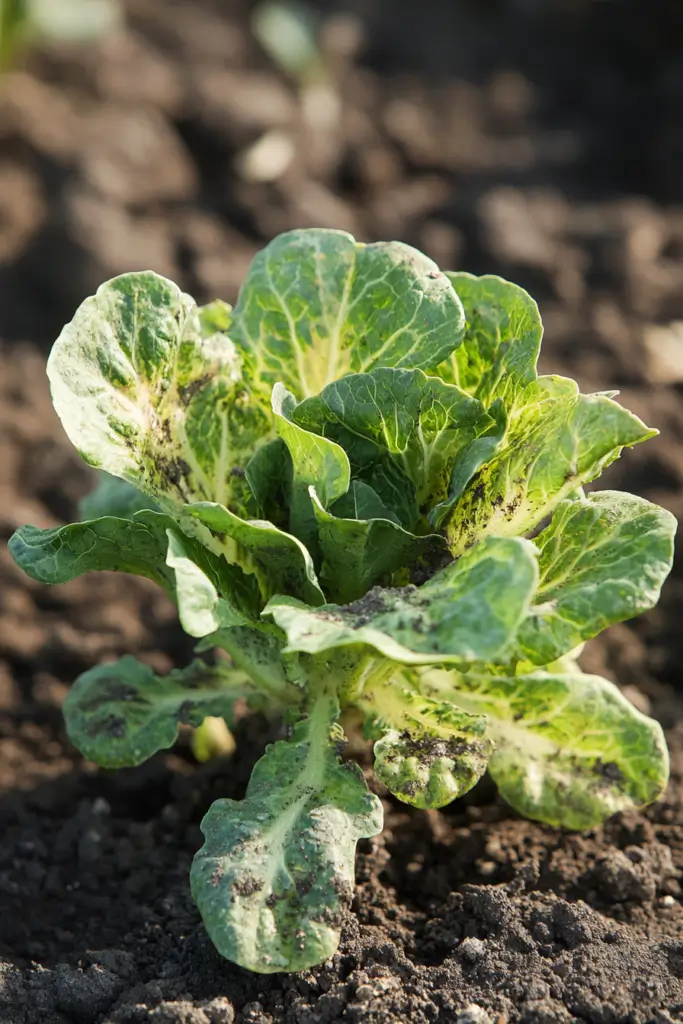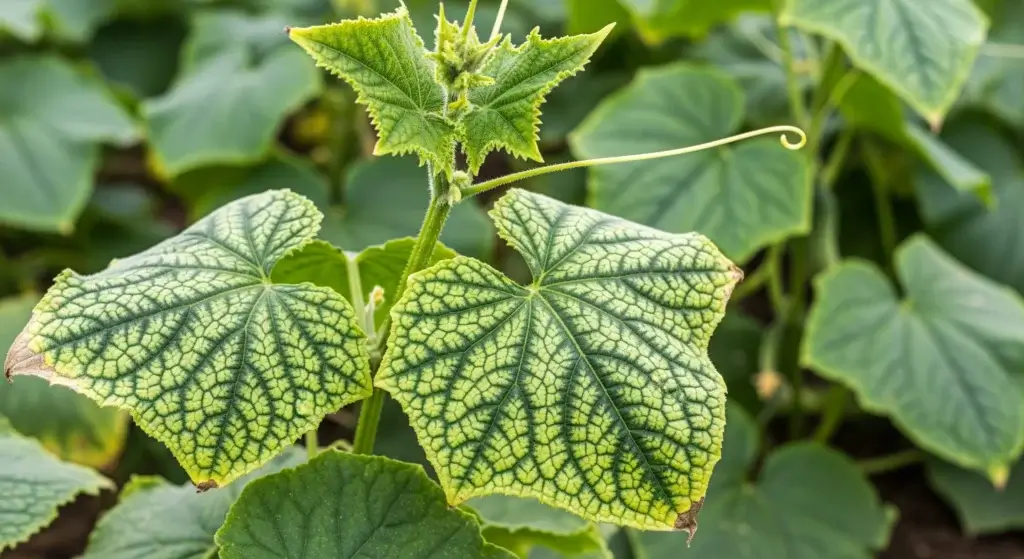
Lettuce is a fantastic vegetable. It’s packed with nutrients, low in calories, and super versatile in the kitchen.
That mild flavor means it goes with just about anything, and it’s so easy to use, whether you’re tossing it in a salad or wrapping it around some tasty fillings.
Plus, growing lettuce is pretty straightforward, which is why so many people try it at home, and it’s obviously a big commercial crop too.
One of the best things is how quickly you can grow it, you can often get several harvests in a single season.
It seems like such a simple plant, right?
But, lettuce is actually susceptible to a number of diseases that can cause real problems if you’re not careful.
You might think ignoring a few spots on the leaves isn’t a big deal, but these diseases can quickly spread and cause serious damage to your lettuce crop.
It’s definitely something growers need to be aware of.
Pathogens That Affect Lettuce
Lettuce is susceptible to a variety of pathogens, including fungi, bacteria, viruses, and oomycetes.
These pathogens can cause significant damage to lettuce crops, leading to reduced yield and quality.
Below is an overview of the major pathogens that affect lettuce and how they work:
Fungal
Fungi are among the most common pathogens affecting lettuce.
They thrive in moist conditions and can spread rapidly.
Downy mildew (Bremia lactucae)
It infects lettuce leaves, causing yellow or pale green spots on the upper surface and white, fluffy growth on the underside.
Infection begins when spores (conidia) germinate on the leaf surface and penetrate through stomata or directly through epidermal cells.
The fungus grows intercellularly, utilizing the plant’s nutrients.
Under favorable conditions (high humidity and suitable temperatures), the pathogen produces new spores that are dispersed by wind, perpetuating the infection cycle.
Powdery mildew (Golovinomyces cichoracearum)
This pathogen infects lettuce primarily through damaged tissues or during high humidity conditions.
It produces conidia that spread via air and water droplets.
The fungus thrives in moist environments, leading to soft rot and decay of plant tissues.
Causes leaf yellowing, curling, and premature death, reducing the plant’s ability to photosynthesize.
Lettuce drop (Sclerotinia spp.)
The fungus produces sclerotia (hard, resting structures) that survive in soil.
Under moist conditions, sclerotia germinate and infect the plant, causing wilting and rot.
Leads to complete plant collapse, especially in mature lettuce.
Anthracnose (Microdochium panattonianum)
Infection occurs through free water on leaves, where spores germinate and penetrate via stomata or directly through leaf surfaces.
The pathogen can survive in soil as microsclerotia for extended periods, waiting for suitable conditions to infect.
Causing small, water-soaked lesions that turn tan or brown.
Reduces leaf quality and marketability.

- Read also: Growing Green: A Guide to Natural Pesticides for Lettuce
- Read also: Caring Your Lettuce: How to Prevent Bolting in Lettuce Plants
Bacterial
Bacterial pathogens often enter plants through wounds or natural openings and can spread rapidly in wet conditions.
Bacterial leaf spot (Xanthomonas campestris pv. vitians)
The bacteria enter through stomata or wounds, causing small, water-soaked spots that turn brown or black with a yellow halo.
It can reduce leaf quality and can lead to defoliation.
Soft rot (Pectobacterium carotovorum)
The bacteria produce enzymes that break down plant cell walls, causing soft, mushy rot.
It often enters through wounds or damaged tissue and then destroys the plant’s structural integrity, making it unmarketable.
Virus
Viruses are often spread by insect vectors and can cause systemic infections in lettuce.
Lettuce mosaic virus (LMV)
Spread by aphids, the virus infects the plant and causes mosaic patterns, leaf distortion, and stunting.
Tomato spotted wilt virus (TSWV)
Spread by thrips, the virus causes ring spots, wilting, and necrosis in lettuce leaves.
Oomycete
Oomycetes, though not true fungi, behave similarly and thrive in wet conditions.
Pythium root rot (Pythium spp.)
The pathogen infects roots, causing damping-off in seedlings and root rot in mature plants.
It thrives in waterlogged soils.
Reduces root function, leading to stunted growth and plant death.
Phytophthora root rot (Phytophthora spp.)
Similar to Pythium, it infects roots and causes rot, particularly in poorly drained soils.
Factors Contributing to Disease Development
The development of diseases in lettuce is influenced by a variety of factors, which can be broadly categorized into environmental conditions, plant structure, and cultural practices.
Understanding these factors is crucial for effective disease management.
Environmental conditions
Temperature and humidity
Lettuce diseases, particularly fungal and Oomycete diseases, thrive under specific temperature and humidity conditions.
For instance, downy mildew is most prevalent in cooler temperatures with high humidity, while Sclerotinia sclerotiorum requires wet conditions and temperatures between 15-25°C for infection to occur.
High relative humidity can also facilitate the spread of pathogens through water-splashing from soil to plants.
Rainfall and irrigation practices
Excessive rainfall or overhead irrigation can create ideal conditions for diseases like Botrytis (grey mould) and ring spot, as water accumulation on leaves promotes pathogen growth.
Conversely, drought stress can weaken plants, making them more susceptible to infections.
Plant structure
Leaf architecture
The physical structure of lettuce leaves significantly impacts disease susceptibility.
Dense leaf types can retain moisture, increasing the risk of fungal infections like grey mould.
In contrast, more open leaf structures allow better airflow and reduced humidity around the plant, which can lower disease risk.
Root health
A healthy root system is essential for nutrient uptake and overall plant vigor.
Compromised roots can lead to increased susceptibility to soilborne pathogens such as Sclerotinia.
Soil health, including drainage and nutrient levels, directly influences root health and thus disease resistance.
Cultural practices
Crop rotation and soil management
Practices such as crop rotation can help manage soilborne diseases by breaking the life cycles of pathogens.
Continuous planting of lettuce in the same area can lead to an accumulation of pathogens in the soil.
Nutrient management
Proper fertilization is crucial for maintaining plant health.
Nutrient deficiencies or imbalances can lead to stress conditions that make plants more vulnerable to diseases.
For example, calcium deficiency is linked to tipburn in lettuce, which can be exacerbated by rapid growth rates during warm weather.

Consequences of Ignoring Lettuce Diseases
Ignoring lettuce diseases can result in severe consequences that affect both your crop and your pocket.
Here’s what can happen if you neglect the warning signs:
Reduced yield
When lettuce plants are infected, they struggle to grow properly.
Leaves may become small, curled, or discolored.
Affected plants often produce fewer leaves or stop growing altogether.
This leads to a smaller harvest, which can be particularly damaging if you depend on lettuce for income or personal consumption.
Poor quality
Diseased lettuce often looks unappealing. Leaves may have brown spots, yellow patches, or mold.
Some may wilt or rot.
Such lettuce is hard to sell at markets or grocery stores.
Even if you grow it for personal use, the appearance and taste can be off-putting, making the crop almost unusable.
Spread to healthy plants
Lettuce diseases rarely stay confined to one plant.
If you ignore a sick plant, the disease can quickly spread to neighboring plants.
Fungal spores can travel through the air, while bacteria can move through water droplets.
Viruses can spread via insects.
Before you know it, your entire garden or field could be affected, making the problem harder and more expensive to control.
Increased costs
Letting diseases spread can hit your wallet hard.
If the infection worsens, you may need to spend more money on fungicides, pesticides, or other treatments.
In severe cases, you might need to remove and destroy entire batches of plants.
Labor costs may also increase, as workers spend more time treating plants or clearing infected fields.
All these expenses can add up quickly.
Health risks
Diseased lettuce is not just an eyesore; it can be dangerous to consume.
Mold, bacteria, and rot can introduce harmful microorganisms into your food.
Eating contaminated lettuce could cause food poisoning, stomach issues, or other health problems.
This is especially concerning for children, elderly individuals, or people with weakened immune systems.

- Read also: Beyond the Label: Are Organic Lettuce Growers Really Pest-Free?
- Read also: Understanding the Threats: Meet 7 Worst Enemies of Lettuce
Management Strategies for Lettuce Diseases
Preventing and managing lettuce diseases requires a proactive approach. Here are some practical strategies to protect your crop:
- Proper spacing: Ensure adequate spacing between plants to promote air circulation and reduce humidity.
- Water wisely: Water at the base of the plants in the morning, avoiding overhead irrigation to keep leaves dry.
- Crop rotation: Rotate crops yearly to prevent the buildup of soilborne pathogens.
- Use disease-resistant varieties: Opt for lettuce varieties bred to resist common diseases like downy mildew and mosaic virus.
- Monitor regularly: Inspect plants frequently for early signs of disease and remove affected leaves or plants promptly.
- Sanitize tools and equipment: Clean gardening tools after use to prevent the spread of bacteria and fungi.
- Improve soil drainage: Avoid water logging by ensuring proper soil drainage and using raised beds if necessary.
Conclusion
Lettuce diseases may start as small spots or subtle wilting, but they can quickly escalate into serious issues if ignored.
The hidden risks range from reduced yields to potential health hazards.
By understanding the common pathogens, recognizing the factors that encourage disease, and adopting effective management practices, you can safeguard your lettuce crop and enjoy healthy, vibrant greens all season long.
FAQs
It depends on the cause. Minor blemishes may be safe after thorough washing, but avoid eating lettuce with signs of rot or mold.
Composting diseased plants is risky unless your compost pile reaches high temperatures that kill pathogens. When in doubt, discard infected plants.
Chemical treatments should be a last resort. Focus on prevention, but if needed, opt for organic fungicides and follow label instructions carefully.



